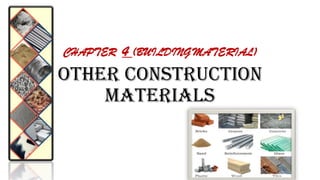This document discusses various construction materials including timber, clay products, refractory materials, and their properties.
It describes the macro and micro structure of timber, including features like annual rings, heartwood, sapwood, and medullary rays. It also discusses the importance of seasoning timber to reduce moisture content. Methods of seasoning include natural air/water seasoning and artificial kiln/chemical seasoning.
Clay products and refractories are classified, with bricks, tiles and pipes as examples of clay products. Refractories must withstand high temperatures and resist chemical/mechanical damage. Examples given are acid, basic and neutral refractories.
The properties and uses of tiles, terracotta and porcelain are outlined


































